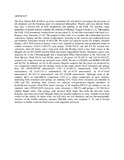Gas geochemistry of volcanic and geothermal areas in the Kenya Rift: implications for the role of fluids in continental Rifting

View/
Date
2013-12-26Author
Lee, H
Fischer, T. P
Ranka, L S
Onguso, B
Kanda, I
Opiyo-Akech, N
Sharp, ZD
Hilton, D R
Kattenhorn, S A
Muirhead, J
Language
enMetadata
Show full item recordAbstract
The East African Rift (EAR) is an active continental rift and ideal to investigate the processes of rift initiation and the breaking apart of continental lithosphere. Mantle and crust-derived fluids may play a pivotal role in both magmatism and faulting in the EAR. For instance, large quantities of mantle-derived volatiles are emitted at Oldoinyo Lengai volcano [1, 2]. Throughout the EAR, CO2-dominated volatile fluxes are prevalent [3, 4] and often associated with faults (i.e. Rungwe area, Tanzania, [5, 6]). The purpose of this study is to examine the relationship between volcanism, faulting and the volatile compositions, focusing on the central and southern Kenyan and northern Tanzanian section of the EAR. We report our analysis results for samples obtained during a 2013 field season in Kenya. Gases were sampled at fumaroles and geothermal plants in caldera volcanoes (T=83.1-120.2°C) and springs (T=40-79.6°C and pH 8.5-10) located near volcanoes, intra-rift faults, and a transverse fault (the Kordjya fault, a key fluid source in the Magadi rift) by 4N-NaOH solution-filled and empty Giggenbach bottles. Headspace gases were analyzed by a Gas Chromatograph and a Quadrupole Mass Spectrometer at the University of New Mexico. Both N2/Ar and N2/He ratios of all gases (35.38-205.31 and 142.92-564,272, respectively) range between air saturated water (ASW, 40 and >=150,000) and MORB (100-200 and 40-50). In addition, an N2-Ar-He ternary diagram supports that the gases are produced by two component (mantle and air) mixing. Gases in the empty bottles from volcanoes and springs have N2 (90.88-895.99 mmom/mol), CO2 (2.47-681.21 mmom/mol), CH4 (0-214.78 mmom/mol), O2 (4.47-131.12 mmom/mol), H2 (0-35.78 mmom/mol), Ar (0.15-10.65 mmom/mol), He (0-2.21 mmom/mol), and CO (0-0.08 mmom/mol). Although some of the samples show an atmospheric component, CO2 is a major component in most samples, indicating both volcanoes and springs are emitting CO2. Gases from volcanoes are enriched in CH4 and H2, denoting their sources are reduced (oxygen-poor) magma chambers or hydrothermal systems. 40Ar/36Ar ratios (average of all samples=299.15) are similar to our air standard value (299.65×4.05), however, some volcanoes (~308.75) and springs (~321.96) have slightly higher ratios. The springs with elevated 40Ar imply that both the intra-rift (Lake Bogoria) and transverse (Lake Magadi) faults are possibly pathways to carry volatiles from deep sources to the surface. In future work, we will carry out wet chemistry and ion chromatography analyses of the NaOH solutions, measure 3He/4He ratios and complete C, N, and S isotope analyses to further constrain fluid sources and migration processes
Citation
Lee, H., Fischer, T. P., Ranka, L. S., Onguso, B., Kanda, I., Opiyo-Akech, N., ... & Muirhead, J. (2013, December). Gas Geochemistry of Volcanic and Geothermal Areas in the Kenya Rift: Implications for the Role of Fluids in Continental Rifting. In AGU Fall Meeting Abstracts (Vol. 1, p. 02).Publisher
University of Nairobi
